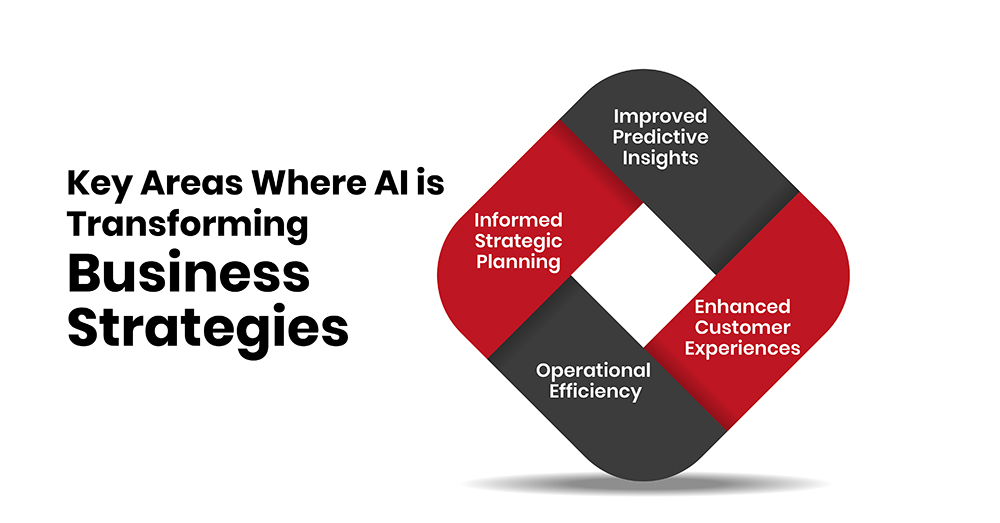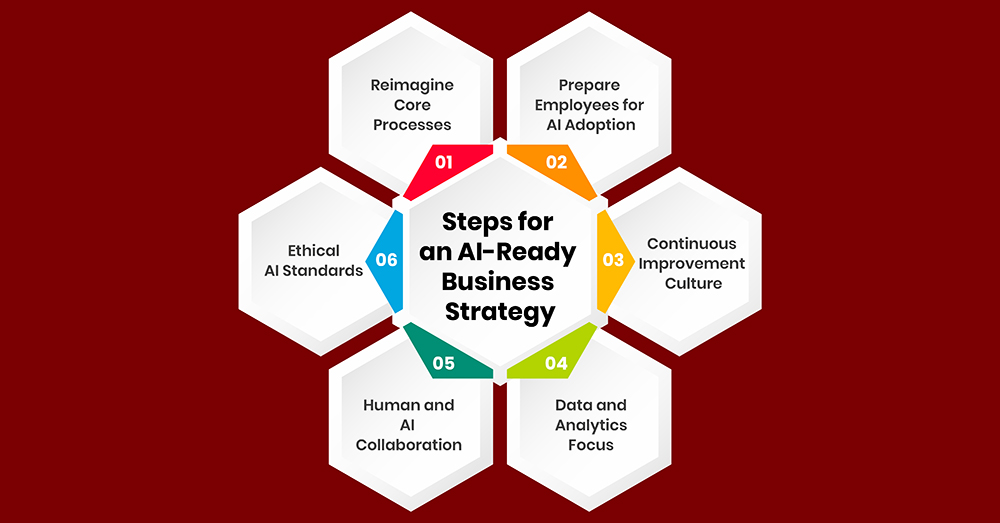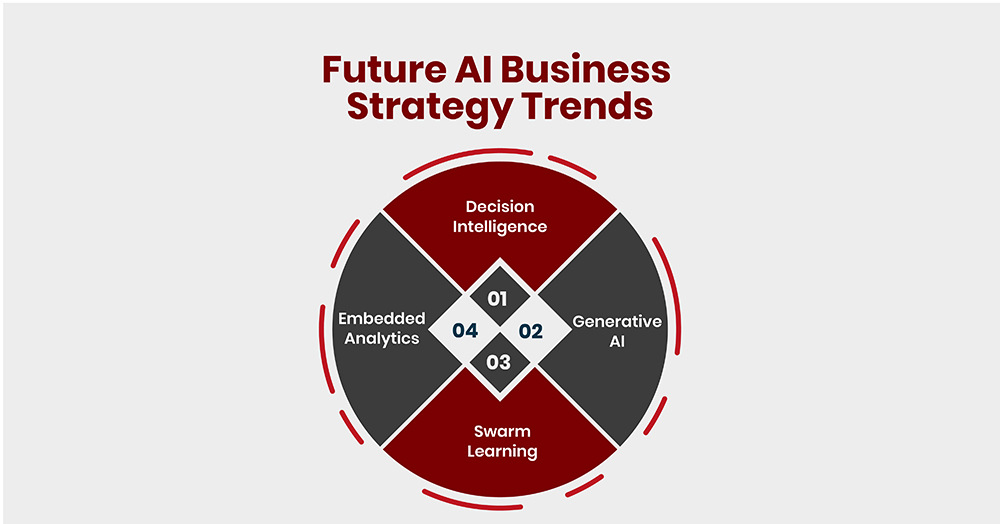AI in business has rapidly evolved from an emerging technology to a business necessity. In 2025, AI is poised to revolutionize industries by reshaping business strategies focused on efficiency, decision-making and customer engagement. Companies that fail to integrate AI risk losing relevance and competitiveness.
AI refers to computer systems that can perform tasks normally requiring human intelligence, such as visual perception, speech recognition, and decision-making. AI encompasses technologies like machine learning, natural language processing and robotics.
As AI solutions become more advanced, they provide unprecedented opportunities for businesses to optimize performance. According to recent surveys, almost 90% of business leaders say AI is fundamental to their company’s strategy today or will be in the next two years.
The ability of AI systems to analyze data, identify patterns, learn from experience and make predictions enables smarter and faster business decisions. AI can also automate repetitive tasks, freeing up employees to focus on more meaningful work.
With the global AI market expected to reach $826.70 billion by 2030, companies are increasingly investing in AI to keep pace with the competition.
Let’s break into the key areas where AI is transforming business strategies:

Predictive analytics is one of the most powerful applications of AI for business strategy. Sophisticated machine learning algorithms can analyze massive datasets related to industries, market conditions and customer behavior to uncover hidden patterns and emerging trends. This can provide amazingly accurate predictive insights to inform better planning.
For example, an ecommerce company can leverage AI to analyze past sales data, search trends, web traffic metrics, pricing experiments, customer reviews and more to develop predictive models. These models can forecast customer demand for upcoming seasons, predictive which products will see high growth and estimate optimal price points.
Armed with such data-driven forecasts, executives can proactively tweak production plans, adapt sourcing and inventory needs, fine-tune marketing campaigns and tailor the product portfolio ahead of time. The ability to foresee challenges or gaps in demand and address them preemptively gives organizations unmatched agility and resilience.
On the innovation front, analyzing macro trends allows businesses to identify customer needs, pain points and market gaps early. This AI-powered foresight helps launch products and experiences that will resonate strongly with audiences once those trends manifest at scale. This first-mover advantage is invaluable in competitive markets.
Creating personalized and contextual customer interactions is no longer a nice-to-have but expected today. Consumers want brands to understand their unique preferences and needs. This is where AI comes in very handy.
Chatbots powered by natural language processing and machine learning can handle routine customer queries accurately while offering a highly responsive self-service channel. Sentiment analysis tools scan conversations and user-generated content to assess how audiences perceive a brand. Recommendation engines use data like past purchases, search history and reviews to suggest relevant products tailored to each shopper’s taste.
Financial institutions apply AI to transaction data to provide personalized investment options. For airlines, AI helps predict customer needs, like suggesting preemptive re-booking options if a flight gets cancelled or purchasing lounge access if long layovers exceed preferred timespans. Such contextual recommendations and individualized experiences increase satisfaction.
AI automation tools lend themselves beautifully for optimizing high-volume and repetitive back-end tasks. Whether it's processing invoices, onboarding new employees or scheduling social media campaigns, AI handles the heavy lifting quickly minus fatigue or human error. This lifts a tremendous workload off employees so they can instead apply their talents to creative, strategic thinking.
A chatbot answering 80% of routine customer queries also ensures agents have the bandwidth to resolve more complex issues. Computer vision AI expedites quality control in manufacturing plants and warehouses by flagging defects and inaccuracies faster than human inspectors. All this drives significant gains in throughput and accuracy, reducing overall costs.
AI process automation also minimizes delays allowing organizations to capitalize on opportunities faster. Consider AI handling tasks like transcription or translation almost instantly - this accelerates international business expansion plans. No wonder most Fortune 500s are aggressively implementing AI automation!
Traditional strategic planning relied heavily on leadership intuition and months of number crunching based on limited datasets. But in our digital era, AI analytics offers real-time insights from a rich tapestry of signals - sales data, financials, media trends, HR records, customer feedback and more. These could hold valuable clues, like emerging customer needs or market shifts. But processing such large, unstructured datasets is impossible manually.
Powerful machine learning algorithms overcome this roadblock by automatically scanning this disparate information to uncover hidden patterns and relationships. These data-driven insights allow leaders to make smart, evidence-based strategic decisions aligned to market realities.
For instance, analyzing three years of sales data might reveal changing regional consumption patterns. Leaders can adapt product portfolios or double down on marketing appropriately. Listening into customer conversations could spotlight recurring complaints, inspiring renewed branding or CX investments. Thus, AI doesn’t just enhance reporting but allows predictive yet agile planning. The future success of any business lies in becoming a truly data-driven organization!
Let’s explore the steps for an AI-ready business strategy:

Rather than force-fitting AI into existing workflows, companies should take a step back and re-evaluate how to optimize processes for AI integration from the ground up. This may involve:
Mapping out current workflows and identifying pain points and inefficiencies that could benefit from automation. For example, manual data entry tasks.
Brainstorming how introducing AI could eliminate frictions at different process stages. Could chatbots handle customer queries more efficiently than agents?
Analyzing the end-to-end process flow and determining the best integration points for AI based on its capabilities. Which parts of the process are best suited for AI versus human judgment?
Redesigning workflows centered around AI augmentation instead of treating AI as an add-on. Set up the workflows with the assumption that certain tasks will be handled by AI.
The key is to reimagine how the entire process could look if built around AI enhancements rather than fitting AI around the existing setup. This AI-first approach helps fully transform legacy business processes to be more scalable, consistent, and efficient.
The successful implementation of an AI strategy relies heavily on employees being prepared to work alongside intelligent systems:
Conduct skills gap analyses to identify reskilling needs as job roles evolve due to automation. Provide training in digital skills like data analysis as well as soft skills like creativity.
Offer change management workshops focused on leading people through organizational AI transformation. Help managers address fears of job losses and guide teams through adjustments.
Encourage learning agility across the workforce as AI requires the continuous acquisition of new technical skills. Incentivize participation in AI training through stipends, bonuses etc.
Promote collaborations between departments to increase AI awareness across the company. Provide forums for employees to discuss or provide feedback on AI implementations.
Proactively reskilling and supporting workers in tandem with AI adoption ensures smoother transitions and increased technology acceptance.
To fully leverage AI's potential, companies need an agile culture obsessed with continuous learning and improvement:
Implement mechanisms like feedback loops to continually gather data on AI system performance and user experience. Open channels for employees to submit input.
Analyze feedback and metrics to identify areas for improving AI solutions. Update machine learning algorithms regularly to enhance predictions, recommendations etc.
Encourage teams to regularly brainstorm new use cases for existing AI tools. Foster an experimental mindset to push boundaries.
Stay updated on the latest advancements through AI training programs. Update older AI if better alternatives emerge.
Document processes and protocols around AI systems to retain organizational knowledge. Cross-train employees across departments on AI best practices.
By continually monitoring, maintaining, and upgrading AI infrastructure, businesses can remain nimble in a fast-changing landscape of technological disruptions.
High-quality data is the lifeblood of AI. Businesses need to prioritize building AI-ready data architecture:
Consolidate data from disparate systems into a centralized, cloud-based data warehouse to enable unified analysis.
Implement data governance protocols covering security, access control, backup etc. Clean data by fixing inconsistencies and inaccuracies.
Incorporate analytics platforms like Power BI that integrate directly with database systems, providing real-time data visualization.
Leverage tools like Azure Machine Learning to rapidly deploy and manage machine learning pipelines that transform data into AI models.
Hire data engineers, scientists, and analysts well-versed in handling large, complex datasets required for training robust AI algorithms.
By investing in solid data infrastructure and talent, companies can gather, process, and extract invaluable insights to continually refine AI systems.
Rather than a handover from human to machine, the most sustainable approach is integrating AI in a way that complements an organization's professional workforce:
Analyze tasks and divide activities between humans and AI based on their respective strengths. Humans handle exceptions, creativity etc. while AI takes on rules-based work.
Design workflows around seamless human-AI collaboration e.g., AI preprocesses loan applications for final human review.
Appoint designated AI trainers on teams responsible for providing additional feedback to improve system accuracy over time.
Institute human-in-the-loop checks before deploying AI to production or acting on insights derived from machine learning models.
With the right governance, AI should empower an organization’s employees to focus their skills on higher-value, meaningful work.
For long-term accountability, AI solutions must be rooted in ethical principles backed by robust governance:
Develop AI ethics frameworks aligned with company values, addressing aspects like privacy, safety, transparency etc. Appoint dedicated AI ethics committees.
Conduct impact assessments before AI deployment to check for potential harms - unfair bias, layoffs etc. Make algorithmic processes explainable.
Implement stringent cybersecurity protocols around access control and encryption to safeguard AI data assets and protect IP.
Perform continuous audits via techniques like red teaming to monitor systems for model drift or deviations from ethical norms.
Comply with existing regulations like GDPR while staying updated on emerging AI governance policies.
By ingraining ethical considerations within the AI development life cycle, progressive self-regulation helps sustain stakeholder and regulatory trust.
As AI capabilities grow exponentially, emerging trends will further transform business strategy in 2025:

Decision intelligence leverages predictive analytics and integrated AI systems to directly inform business actions, rather than just providing insights. In 2025, decision intelligence will be a key way that companies augment existing business intelligence capabilities.
For example, an AI-powered supply chain analytics system could analyze predicted sales volumes, weather data, transportation costs and inventory levels. It would then directly initiate orders with optimal quantities and logistics to meet demand. This automates and optimizes decision-making and operational processes.
Adding predictive analytics directly into business workflows with decision intelligence allows companies to take the right actions at the right times based on AI recommendations. This provides a competitive advantage through improved agility, efficiency and performance.
Generative AI allows text, images and videos to be automatically generated from natural language descriptions. In 2025, generative AI will transform content marketing and creative processes for businesses.
For example, generative AI can produce product photos, social media posts, blog articles and ad copy by simply prompting it with a description of what you need. This automates repetitive and time-consuming content production. It also allows for instantly testing many personalized content variations at scale.
With generative AI, marketing and creative teams can rapidly produce endless high-quality, customized content to improve conversion rates. It liberates human creators to focus on higher-value strategy and planning.
Swarm learning enables interconnected AIs to share learnings and insights with each other via neural networks to rapidly achieve higher capability. During 2025, companies will utilize swarm learning to improve performance across departments.
For example, a fleet of delivery drones could be connected via swarm learning. When one drone develops a more efficient routing algorithm or learns how to handle new weather conditions, it shares this with the swarm to enhance performance fleet-wide.
As companies integrate AI across business functions from production to marketing, swarm learning allows these AI systems to learn from each other, rather than just learning in isolation. This accelerates innovation and optimization.
Rather than analytics being accessible only through separate business intelligence tools, embedded analytics integrates it directly into everyday platforms and workflows. This makes AI-powered data analysis and insights readily available to improve decision-making.
For example, an inventory management system could have real-time embedded dashboards that track shelf life, storage conditions and expiration dates automatically with computer vision. It alerts staff when issues arise and directs them to take preventative actions.
By embedding analytics capabilities within their existing tech stacks, companies remove friction and enable fact-based rapid decision-making fueled by AI across every business function. This shifts organizations from periodic reporting to continuous intelligence.
As companies ride the AI wave into 2025, competitive differentiation will rely heavily on utilizing AI. Businesses that turn insights into innovations and efficiency gains will be primed for growth. Adopting an artificial intelligence-first strategy with continuous upgrades is key to future-proofing success.

CredBadge™ is a proprietary, secure, digital badging platform that provides for seamless authentication and verification of credentials across digital media worldwide.
CredBadge™ powered credentials ensure that professionals can showcase and verify their qualifications and credentials across all digital platforms, and at any time, across the planet.

Keep yourself informed on the latest updates and information about business strategy by subscribing to our newsletter.